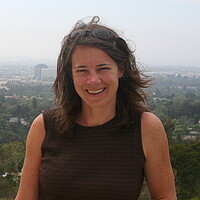Climate scientist steps out of the lab and into the wind
| Boulder, Colo.
When David Goodrich retired from the National Oceanic and Atmospheric Administration, he decided to combine his dual loves of cycling and climate. In 2011, the climate scientist began a cross-country bicycle tour of the United States, talking with people about global warming along the way. Dr. Goodrich’s book about the trip, “A Hole in the Wind,” came out this summer. The Monitor’s Amanda Paulson recently caught up with him in Boulder, Colo. Some excerpts follow:
Q: What inspired your trip?
I’ve been a bicycle commuter for a long time.... [But as] I got closer to retirement, I thought: Wow, I could go across [the country] and talk to people about climate.
Q: What did you learn from those conversations?
I found that the word “climate” has been defined as a political issue. It was always a science issue for me. You can talk about the latest drought that’s going on, or the big heavy rains we’ve been having, and on the coast you can talk about, “Boy, there’s been a lot of flooding.” But if you say, “Isn’t that climate change?” or “Isn’t that sea level rise?,” there’s this wall that goes up.
Q: What did you find inspiring?
I come from a science community ... but it’s not like these people are ignorant. I talked to a couple of farmers in Kansas, in the middle of the drought of 2011 – a pretty big drought – who said, “My yield is down, I have fuel bills, seed bills.” They say, “You’ve got to get big to survive. I don’t know if this is going to work.” In a lot of ways, they know the weather better than I do.
Q: What’s different about traveling by bike?
It’s what you hear that you don’t hear from a car. I was in all that wind in Kansas, and the wind in a wheat field makes a hiss. I remember listening to the hiss. In Wyoming in the middle of sagebrush country, I was hearing a caw like a crow, and there were no birds.... around there. I looked out into the sagebrush, and there’s an antelope. It’s their distress call.
Q: Are you optimistic?
When I first rode across Kansas in 2011, it was amazing how much wind I was getting and how few wind farms there were. That has changed completely.... There’s been a huge growth in wind farms across the Plains. Oklahoma is competing with Wyoming for who’s got the biggest wind project; Texas is the biggest wind-producing state. These places are not where you would necessarily find people saying climate change is real, but they’re a huge part in the move toward renewable energy. You don’t necessarily have to buy into climate change to be a part of the solution.






